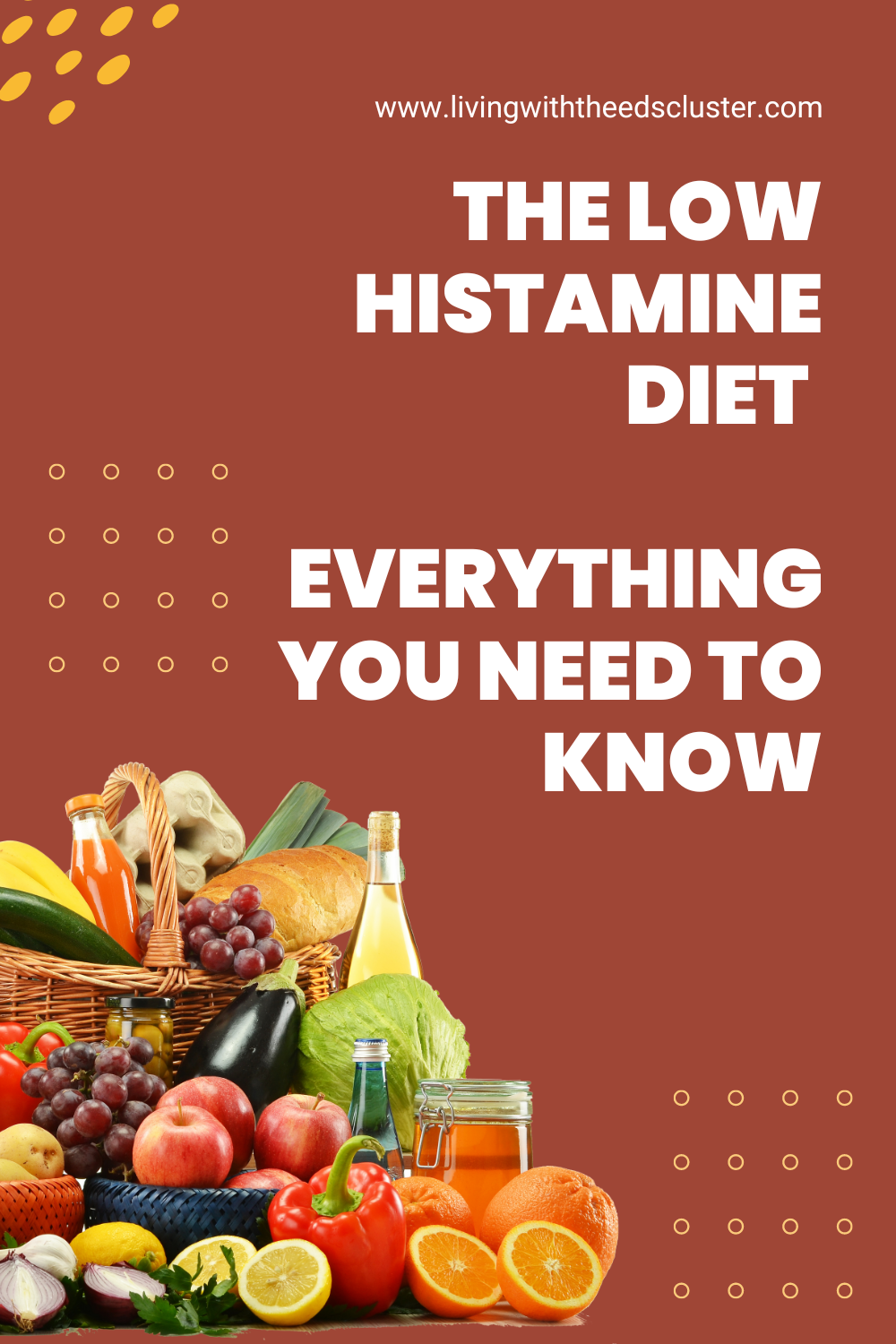Are you looking for a way to improve your health and wellbeing? A low histamine diet might be the answer. A low histamine diet is a diet that helps reduce levels of histamine in your body by avoiding foods high in histamine. This diet has been found to have many health benefits, including reducing inflammation, allergies, headaches, and skin issues. In this blog post, we will discuss everything you need to know about the low histamine diet – from what it is, how to follow it, and its health benefits – so that you can decide if it’s right for you.
I have Mast Cell Activation Syndrome (MCAS), which is part of the Ehlers-Danlos Syndrome (EDS) Cluster. My MCAS is pretty bad. I’ve been on the low histamine diet for about a year now. It really does help! I can tell you that it is not always fun – it is quite restrictive. BUT, I’d rather that than going into anaphylactic shock from a food on the no-list while out at dinner with friends. And yes, that did happen. It consisted of my friend asking why my eyes were looking “funny,” me getting a little offended, and then my husband yelling at me to get my Epi-pen. After a trip to the ER, I realized I really couldn’t “cheat” this diet – I had to follow the rules for my own health.

What is a Low Histamine Diet?
When it comes to allergies and intolerances, many of us turn to food to relieve our symptoms. But food isn’t always the answer – in fact, it can be the root of our problems. That’s where a low histamine diet comes in – designed to reduce the amount of irritation-causing compounds our body releases during an allergic reaction. As we all know, histamine is the compound responsible for all that histamine-y-ness. So, by eliminating high histamine foods like aged cheese and fermented beverages, as well as encouraging fresh fruits, vegetables, and unprocessed meats instead, we’re taking a big step in reducing histamine levels. Additionally, antihistamines are usually taken daily alongside a well-balanced diet for best results. But even with all of this information, it can be hard to stick to a low histamine diet. That’s why it’s important to have regular histamine monitoring to make sure your symptoms are under control!
MCAS and a Low Histamine Diet
People with Mast Cell Activation Syndrome (MCAS) are often advised to follow a low histamine diet in order to reduce the risk of histamine-related symptoms. Histamines are found in certain foods and can trigger symptoms of MCAS such as headaches, hives, or digestive issues. To reduce the risk of these reactions, people with MCAS should avoid high-histamine foods like aged cheeses, smoked meats, and fermented products. Fresh fruits and vegetables are a good source of antioxidants, vitamins, and minerals, which are all good for histamine-free living. Alongside histamine-free food, drinking plenty of water and avoiding caffeine are also recommended. For those following this dietary protocol, eating low-histamine alternatives like gluten-free bread and pasta can be helpful as well.

Benefits of a Low Histamine Diet
Histamine is a natural compound that is produced in the body during allergic reactions and during food digestion. It can cause inflammation, allergies, and other health problems. Therefore, it is important to reduce histamine intake through a low histamine diet. This diet eliminates foods that are high in histamine and replaces them with more nutritious options. These include fresh fruits, vegetables, whole grains, lean proteins, and supplements. This diet can help reduce symptoms of allergies, migraines, asthma, and other health conditions. It’s also a great way to improve overall health and wellbeing. If you’re looking to improve your histamine-free diet, make sure to check out histamine-free diet supplements that can help boost nutrient intake.

Foods to Eat on a Low Histamine Diet
Histamine intolerance is a condition that affects up to 15% of the population. It’s a reaction to histamine-containing foods, which can cause symptoms like itching, hives, asthma, and headaches. To avoid histamine intolerance, it’s important to follow a low histamine diet. This diet involves avoiding certain foods that can trigger allergies or sensitivities. Some of these include dairy, seafood, processed meats and fish, citrus fruits and tomatoes. On the other hand, fresh fruits and vegetables like mushrooms, cucumbers and apples are generally safe to eat on a low histamine diet. It’s also important to pay attention to food labels as some products may contain hidden sources of histamines such as preservatives or colorants.

Foods to Avoid on a Low Histamine Diet
Chronic illnesses like allergies and asthma are on the rise, and there’s a good reason for it. The low histamine diet is designed to reduce inflammation and symptoms of allergies or chronic illnesses. Foods high in histamine, like aged cheeses, dried fruit, smoked fish, and processed meats, can cause inflammation and symptoms in people with histamine intolerance. Alcohol can also trigger reactions so it should be avoided when following this diet plan. Low-histamine foods include fresh fruits and vegetables, lean proteins such as eggs and tofu, herbs & spices, gluten free grains etc.. If you’re looking to follow a histamine-friendly diet, make sure to consult with a health professional first.

SIGHI Food List
The SIGHI food list is a comprehensive guide to foods low in histamine content. It includes fruits, vegetables, meats and fish, dairy products, grains and legumes. The list gives a grade of 0-3 (well-tolerated to very poorly tolerated/severe symptoms). I try to stick with 0’s and 1’s, and only eat 2’s sparingly. I try to never eat 3’s. This document from the Swiss Interest Group Histamine Intolerance (SIGHI) is the best resource I have found for low histamine food. I highly recommend printing it out and taking it with you grocery shopping or to restaurants. I have another post that details all the 0’s and 1’s, so it’s a little easier to know what you can eat, as opposed to what you shouldn’t eat.

Step by Step Guide To Getting Started
This step-by-step guide will show you how to get started.
- First, keep a food diary to identify any potential triggers. This is actually very important, in that there can be secondary foods you wouldn’t even think of that are causing you issues. Writing down everything will help you determine the true culprits.
- Once you’ve identified these, start eating as many fresh and unprocessed foods as possible. This includes fruits, vegetables, lean proteins, and dairy products that are low in histamine.
- Next, avoid high-histamine foods like aged/smoked meats and processed snacks.
- To support gut health, take supplements that support gut health including probiotics, digestive enzymes, and glutamine.
- Finally, begin the low histamine diet by gradually decreasing histamine-containing foods over time.

Final Thoughts
When it comes to food allergies and sensitivities, it’s hard to know where to turn. That’s where the low histamine diet comes in. It can help reduce inflammation and improve symptoms associated with sensitivities to certain foods. While following the diet, be mindful of the dietary restrictions and aim for well-rounded nutrition by incorporating fresh fruits, vegetables, whole grains, legumes and healthy fats into your meals. If you are experiencing digestive issues or food allergies, it may be beneficial to consult a doctor before starting a new diet plan. With careful planning and balanced meal choices, the low histamine diet can promote improved overall health!

Conclusion
A low histamine diet is a great way to reduce histamine-related symptoms, as its worked for me. By understanding the foods to eat and foods to avoid, you can easily create a low histamine diet that works for you. Additionally, it’s important to keep in mind that histamine-induced symptoms can also be caused by other issues such as food allergies or intolerances. Always consult your doctor before making any changes to your diet.
Other great sources to review are:


One response to “The Low Histamine Diet – Everything You Need To Know”
[…] mentioned in my prior post about the low histamine diet, histamine is a natural compound that is produced in the body during […]